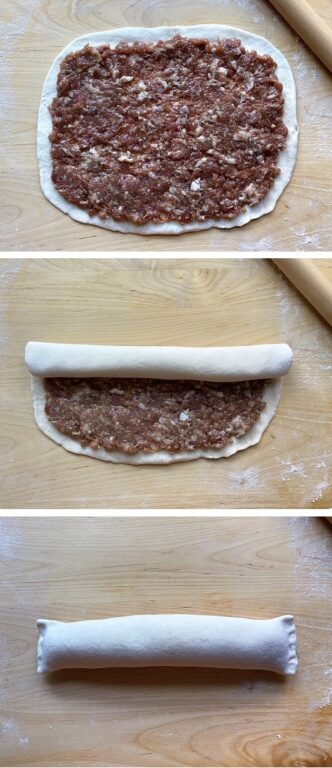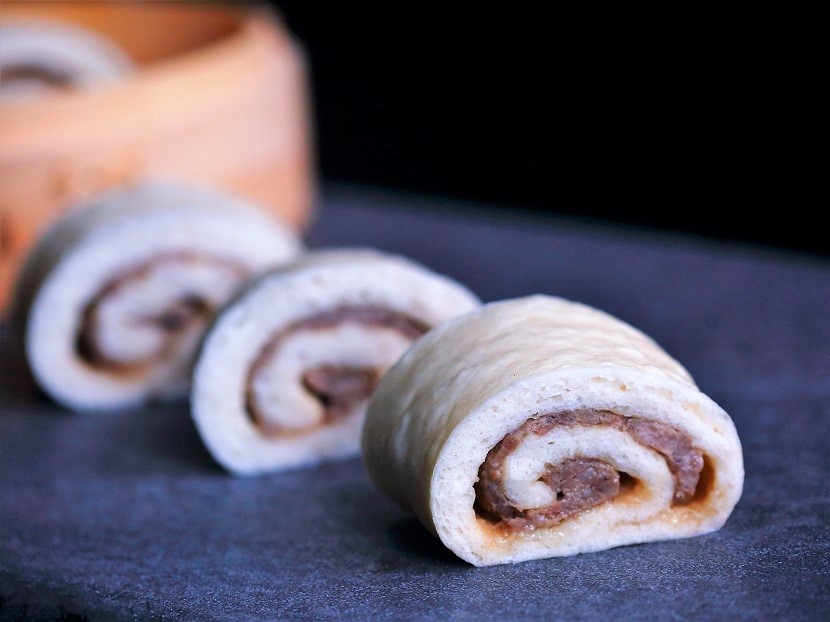Last Updated on October 24, 2020 by Simon Fan
The street food and snacks in Beijing are among the best and most varied in China. Some of the local favorites include jianbing (煎饼), fried dough rings, boiled lamb or beef tripe, mung bean milk, tea soup, sugar-coated haws, and, of course, the steamed meat-filled rolls called lazy dragon.
Although steamed buns stuffed with savory or sweet fillings are ubiquitous in northern China, lazy dragon (lanlong 懒龙) is unique to Beijing. While making the stuffed buns requires rolling individual wrappers and forming enclosed pouches, creating the fluffy, meaty, and juicy lazy dragon rolls is much easier: roll the yeast dough into a large rectangular or oval sheet, spread the meat filling evenly over the sheet, and then roll the sheet up like a jelly roll. When the roll is laid, slightly coiled up, in the steamer, it resembles a sleeping dragon, hence the fun name. Once steamed, it is cut into small rolls or wedges for serving. By the way, lazy dragon can also be called meat dragon or roulong (肉龙).
If you’ve made Chinese buns, dumplings, or Western-style cheese or jam rolls, creating lazy dragon would be a walk in the park. Even if you don’t have such experience, making these rolls will be fun and rewarding.
In Beijing, ground pork or beef is typically used as the filling for the rolls, though I think ground chicken would be a good option too. Sometimes chopped local bunching onion (jingcong 京葱) is mixed into the meat. Chinese five-spice powder or thirteen-spice powder (shisanxiang 十三香), together with sesame oil, is often added to give the filling an enticing aroma.
In my recipe below, instead of making a large roll and then coil it up in the steamer, I divide the dough into two equal portions and make two shorter rolls that fit nicely (without coiling) into a 10-inch (25 cm) two-tier steamer. This way, I can cut them into small uniform rolls for serving (instead of a mix of rolls and wedges cut from a coiled roll).
Feel free to adjust the seasoning to your liking when you try the recipe. You can also use the same method to create dessert rolls with a sweet filling such as red bean paste or sesame paste. Beijing locals call such sweet treats “flower rolls.”
Steamed lazy dragon rolls, old Beijing style (老北京懒龙)
Makes 2 rolls, to be cut into 12 pieces for serving
Filling
2 scallions, cut into 1-inch (2.5 cm) length
1-inch (2.5 cm) piece of ginger, thinly sliced
2 tablespoons water
8 oz (230 g) ground pork, preferably 30% fat, or substitute beef or chicken
¼ teaspoon salt
¼ teaspoon freshly ground white pepper
1 tablespoon soy sauce
½ teaspoon sugar
1 teaspoon Shaoxing wine
¼ teaspoon Chinese five-spice powder or thirteen-spice powder (optional)
2 teaspoons sesame oil
Dough
8⅘ ounces (250 g) all-purpose flour, plus more for dusting
1 teaspoon (⅒ ounce/3 g) instant dry yeast
1 scant teaspoon (⅒ ounce/3 g) baking powder
1 teaspoon sugar
4¾ fluid ounces (140 ml) warm water, around 120°F (49°C)
Directions
- Place the scallion, ginger, and water in a small bowl. Crush the scallion and ginger with your hand, squeeze to release their juices into the water, and discard the solids. In a large bowl, mix the pork with the salt, pepper, soy sauce, sugar, wine, and five-spice powder, stirring with your hand or a pair of chopsticks vigorously in one direction for about 1 minute. Gradually add the scallion-ginger-flavored water from the small bowl into the mixture, stirring in the same direction until the water is well absorbed. Mix in the sesame oil.
- To make the dough, add the flour, yeast, and baking powder to a large bowl, and whisk to mix well. Dissolve the sugar in the water, then slowly add the water to the flour mixture while stirring with a pair of chopsticks to form large flakes. Knead briefly until the mixture starts to come together, then scrape it onto a lightly floured work surface. Knead until the dough is very smooth and soft, and does not stick to either your hand or the work surface. Form the dough into a ball, cover it loosely with plastic wrap, and let rest for 5 minutes.

- When the dough is ready, knead it briefly on the work surface. Divide the dough into 2 equal portions. Working with one portion at a time, roll the dough into a cylinder shape, then flatten it into an approximate rectangle. Using a rolling pin and dusting with flour as needed, roll the dough, from the center to the edges, into a rectangular sheet about 9½ x 8 inches (24 x 20 cm). Spread half of the pork mixture evenly over the sheet, keep the edges clear by ½ inch (1.3 cm). Roll up the sheet from one long edge to the other to form a large roll and turn the seam side down. Pinch the ends to seal. Repeat with the remaining dough and filling.
- Place the rolls, seam side down, in a 10-inch (25 cm) two-tier steamer lined with perforated parchment paper. Cover loosely with plastic wrap, and leave them to rise at room temperature until they approximately double in size, about 40 minutes.
- Bring a pot of water to a boil, and steam the rolls over high heat, switching the 2 tiers halfway through to ensure even cooking, until the rolls are cooked through and fluffy, about 20 minutes. Turn off the heat and leave the rolls in the steamer for a few minutes before removing them from the pot.
- Cut the rolls crosswise into 1½-inch (4 cm) pieces and serve.



